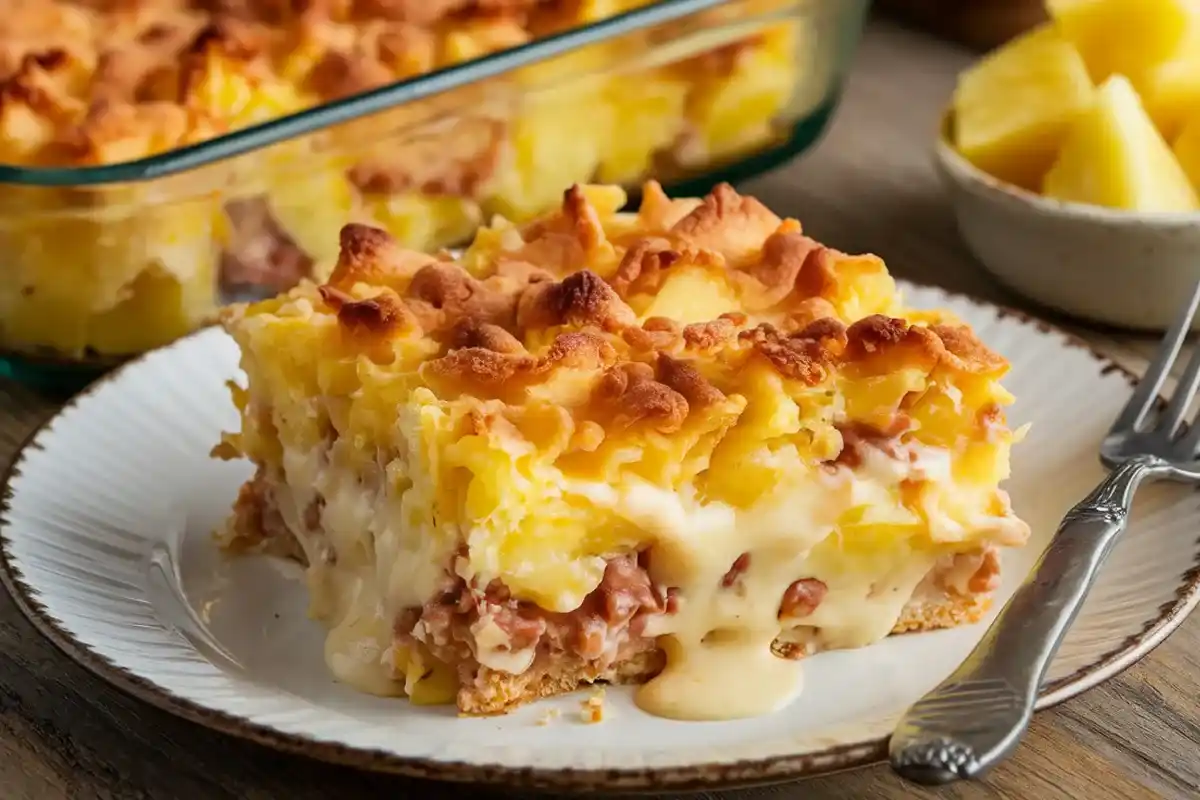Pineapple casserole may not be the first dish that springs to mind when you think of comforting casseroles, but this sweet-and-savory recipe has earned its spot at the table. Whether it’s served as a decadent side dish or a surprising dessert, pineapple casserole has a way of delighting guests and families alike. In this article, we’ll look at what makes this Southern classic so special, walk you through the key ingredients, and offer some tasty variations. By the end, you’ll know exactly how to create a dish that’s easy to prepare and impossible to forget.
Ingredients for the Perfect Pineapple Casserole
Key Ingredients You’ll Need
Every great pineapple casserole recipe starts with a handful of simple ingredients. First, you’ll need canned pineapple—either chunks or crushed—because its natural sweetness forms the dish’s foundation. Sharp cheddar cheese brings the savory contrast that sets this casserole apart. You’ll also want Ritz crackers (or a similar buttery variety) for that delightful crunchy topping.
Butter and sugar round out the flavor profile, adding richness and just the right amount of sweetness. With these staples in hand, you’re on your way to creating a memorable casserole that’s as comforting as it is unique.
Tips for Selecting the Best Ingredients
The quality of your ingredients can make or break the final dish. When choosing pineapple, go for high-quality canned options without added syrup. If you prefer a bolder flavor, opt for extra-sharp cheddar cheese. This gives the casserole a more pronounced savory note, balancing the natural sweetness of the pineapple.
For the crackers, Ritz is the traditional choice, but any similar buttery, flaky cracker will do. Always use real butter, not margarine, for a rich, authentic taste. By selecting the freshest, most flavorful ingredients, you’ll elevate this simple recipe into something truly special.
How to Make Pineapple Casserole
Step-by-Step Instructions
- Start by preheating your oven to 350°F (175°C). This ensures your casserole bakes evenly.
- Drain your canned pineapple thoroughly to avoid a soggy casserole. In a large bowl, mix the pineapple chunks or crushed pineapple with sugar and grated cheddar cheese.
- Transfer the mixture to a greased baking dish, spreading it out evenly.
- Crush your Ritz crackers and sprinkle them generously over the pineapple mixture.
- Melt butter and drizzle it over the cracker topping to help it turn golden and crisp as it bakes.
- Place the dish in the oven and bake for about 30-35 minutes, or until the topping is golden brown and the casserole is bubbling around the edges.
- Remove from the oven and let it rest for 5-10 minutes before serving.
Expert Tips for Perfect Results
For the best results, make sure your pineapple is well-drained. Too much liquid can make the casserole watery. Adjust the sugar to your taste—if you prefer a slightly less sweet dish, reduce it by a tablespoon or two. For a richer flavor, consider using half-sharp cheddar and half-Colby cheese. Finally, if you like a thicker topping, add a few extra crackers and a touch more butter. By following these simple tips, your pineapple casserole recipe will come out perfectly every time.
Variations and Add-Ons for Pineapple Casserole
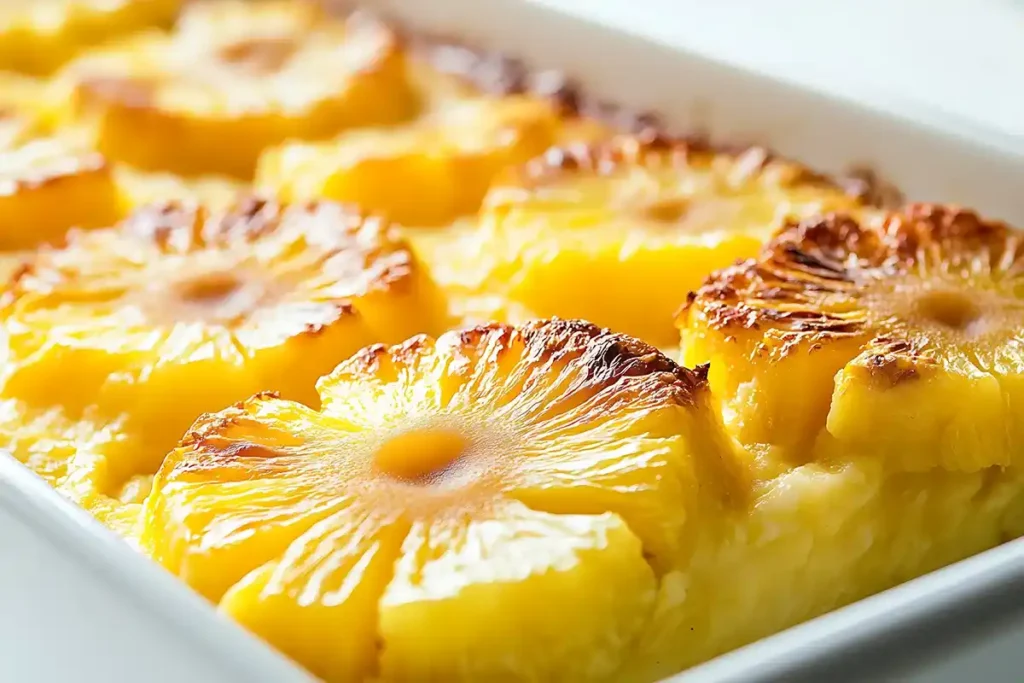
Creative Twists to Try
When you’ve mastered the classic pineapple casserole recipe, you can start exploring fun variations to make it your own. For instance, consider mixing a handful of chopped pecans into the cracker topping for a little extra crunch. You might also sprinkle in a pinch of cinnamon or nutmeg to give it a warm, holiday-inspired flavor. These small changes can bring a whole new dimension to the dish while still keeping it delightfully simple.
If you’re feeling adventurous, try adding a layer of cooked and crumbled bacon for a savory twist. This not only balances the sweetness of the pineapple but also makes the casserole heartier and more satisfying. Another option is to experiment with different cheeses. While sharp cheddar is traditional, a mix of cheddar and Gruyère or even Monterey Jack can create a creamier, slightly tangy flavor profile.
If you’re craving even more sweet inspiration, check out our moist fluffy kefir sheet cake for a tangy, delicious complement to this classic lemon dessert.
How to Make It Your Own
Personalizing your pineapple casserole recipe doesn’t have to mean a complete overhaul. Small tweaks can go a long way. If you’re accommodating dietary restrictions, try swapping out the standard Ritz crackers for a gluten-free version. You can even incorporate a drizzle of honey or a light scattering of toasted coconut on top for a tropical flair.
If you’re hosting a gathering, consider portioning the casserole into individual ramekins. This not only adds a touch of elegance but also ensures everyone gets a perfectly crispy topping. By adding your signature touches, you’ll turn a well-loved classic into a uniquely memorable dish.
How to Store and Reheat Pineapple Casserole
Storing Pineapple Casserole
After enjoying your delicious pineapple casserole recipe, you might end up with leftovers. Storing it properly is simple. Transfer the cooled casserole into an airtight container, or cover the baking dish tightly with plastic wrap or foil. Then, place it in the refrigerator. When stored correctly, it will remain fresh for up to three days.
If you prefer to freeze the leftovers, scoop individual portions into freezer-safe containers or use heavy-duty freezer bags. Be sure to remove as much air as possible to prevent freezer burn. Frozen casserole can be kept for up to three months.
Reheating Tips
When you’re ready to enjoy the leftovers, the best approach is gentle reheating. For refrigerated casserole, preheat your oven to 350°F (175°C) and reheat in a covered dish until warmed through. If you’re in a hurry, the microwave works too—just cover the dish with a microwave-safe lid and heat in short intervals, stirring occasionally.
For frozen casserole, let it thaw in the refrigerator overnight before reheating. This helps maintain its texture and prevents uneven heating. By following these simple steps, you’ll keep your pineapple casserole recipe tasting just as delicious as when it was freshly baked.
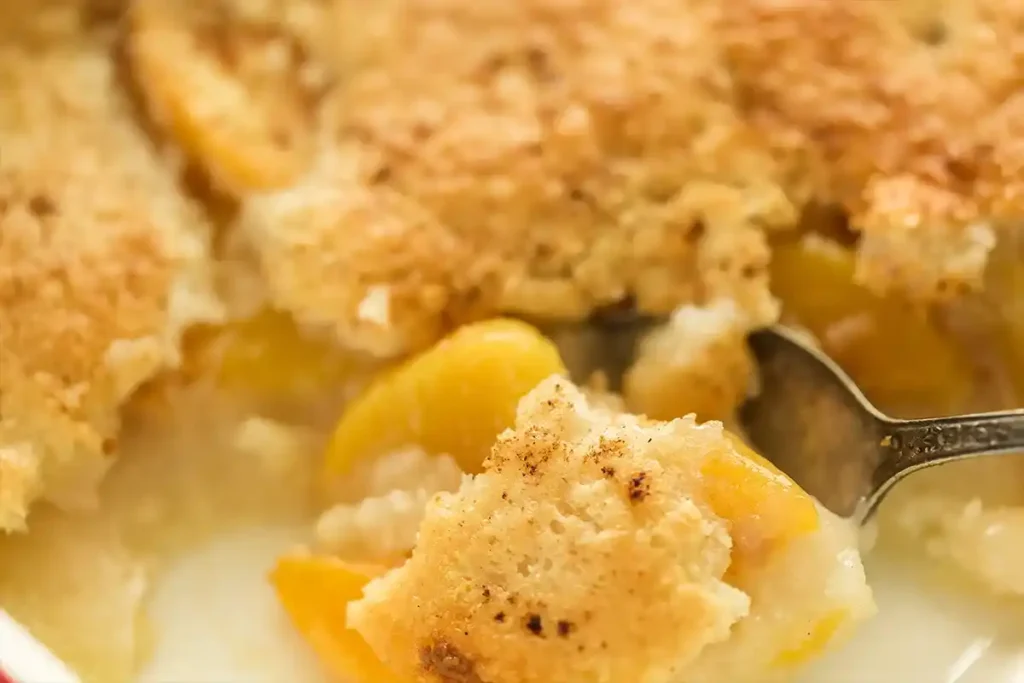
Nutritional Information and Dietary Considerations
Nutritional Breakdown
A standard serving of pineapple casserole typically includes pineapple, cheese, butter, sugar, and crackers. While it’s not exactly a low-calorie dish, you can estimate about 200-250 calories per serving, depending on portion size and ingredient choices. The sweetness comes from both the fruit and the added sugar, while the cheese contributes protein and calcium.
The topping, made from crackers and butter, adds fat and carbs that create that signature crunch. Keep in mind that these values are just a rough guideline, and slight variations will occur based on the specific brands and measurements used.
Adapting the Recipe for Special Diets
If you’re looking to make your pineapple casserole recipe fit certain dietary needs, consider the following tweaks:
- For a lower-carb version, use a sugar substitute or reduce the amount of sugar.
- To cut back on fat, opt for reduced-fat cheese and butter alternatives.
- If you’re cooking for a gluten-free crowd, choose gluten-free crackers and ensure all other ingredients are certified gluten-free.
These small adjustments allow you to enjoy this comforting dish while aligning with your health goals or dietary preferences.
Additional Serving Suggestions
Pairing Ideas
Pineapple casserole is versatile and works well as a side dish or even a dessert. For a savory meal, serve it alongside honey-glazed ham, roasted turkey, or baked chicken. The natural sweetness beautifully complements the smoky, salty flavors of these proteins. If you prefer a lighter pairing, consider a simple green salad or steamed vegetables to balance out the richness.
Presentation Tips
To make your pineapple casserole recipe stand out on the table, think about the presentation. Bake it in a clear glass dish so the golden topping is visible. For a festive look, garnish with a few pineapple slices or a sprinkle of chopped herbs. These small touches not only enhance the dish’s appeal but also make it more inviting for guests.
Want more dessert inspiration? You might enjoy our chocolate cream cheese pound cake recipe—it’s a rich and satisfying treat that complements any occasion.
FAQs About Pineapple Casserole
Can I use fresh pineapple instead of canned?
Absolutely! While canned pineapple is convenient, fresh pineapple can add a vibrant, natural sweetness. Just be sure to dice it finely and let it sit in a colander for a bit to remove excess juice. This way, your casserole won’t end up too watery.
What should I serve with pineapple casserole?
Pineapple casserole pairs beautifully with a variety of main dishes. It’s often served alongside baked ham, making it a popular choice for holiday meals. You could also try it with roasted chicken or pork tenderloin. The savory and sweet combination complements these proteins perfectly.
Can pineapple casserole be made ahead of time?
Yes! Preparing it a day ahead can save time, especially during busy holidays. Simply assemble the casserole and store it covered in the refrigerator. When you’re ready to serve, bake it as directed. The flavors meld together beautifully when given a bit of time to rest.
How can I make pineapple casserole healthier?
If you’re looking to lighten up your pineapple casserole recipe, consider using a sugar substitute or reducing the sugar by half. You might also swap the crackers for a whole-grain variety and use reduced-fat cheese. With these adjustments, you can enjoy the same great taste with fewer calories and less fat.
Can pineapple casserole be frozen?
Yes, but it’s best to freeze it before baking. Assemble the casserole as usual, cover it tightly with plastic wrap and aluminum foil, and freeze for up to three months. When you’re ready to enjoy it, let it thaw overnight in the refrigerator, then bake as directed.
Final Encouragement and Inspiration
When it comes to comforting, crowd-pleasing dishes, pineapple casserole stands out as an irresistible option. Its unique combination of sweet and savory flavors, combined with a crunchy topping, makes it a memorable addition to any meal. From holiday feasts to casual gatherings, this simple casserole earns its place at the table every time. Its appeal lies not just in its distinctive taste, but also in how easy it is to prepare and customize.
As we’ve seen, a well-made pineapple casserole requires only a handful of ingredients: canned pineapple, sharp cheddar cheese, crackers, butter, and sugar. These pantry staples come together to create something truly special. Whether you’re a seasoned cook or just starting out, this dish is approachable and forgiving. You don’t need fancy techniques or special equipment—just mix, layer, bake, and serve.
Conclusion
In addition to its simplicity, pineapple casserole is wonderfully versatile. It can be a side dish that balances the richness of a ham or turkey dinner, or a stand-alone dessert that surprises and delights with every bite. The sweet pineapple and buttery cracker crust offer a perfect contrast that satisfies multiple cravings at once. And for those who enjoy putting their own spin on classic recipes, there are countless ways to make it your own. Adding spices, experimenting with different cheeses, or incorporating nuts are just a few ways to personalize the dish. You can even adjust the sweetness or try a gluten-free variation—this casserole adapts beautifully to all kinds of preferences.
Ultimately, pineapple casserole is more than just a dish—it’s an experience. It’s a conversation starter, a comfort food, and a reminder that the simplest ingredients can come together to create something extraordinary. Whether you’re introducing it to friends for the first time or carrying on a family tradition, this casserole is sure to leave a lasting impression. It’s easy to make, endlessly adaptable, and irresistibly delicious—a true gem of home cooking.
This unadulterated Pineapple Casserole Recipe such a gem, and if you have attempted it, it would be highly appreciated if you could drop a comment with stars to let me know how it turned out for you! It gives me joy to hear from you – it encourages me to come up with more and more recipes for you guys😊 Ready, steady, cook! – Emily
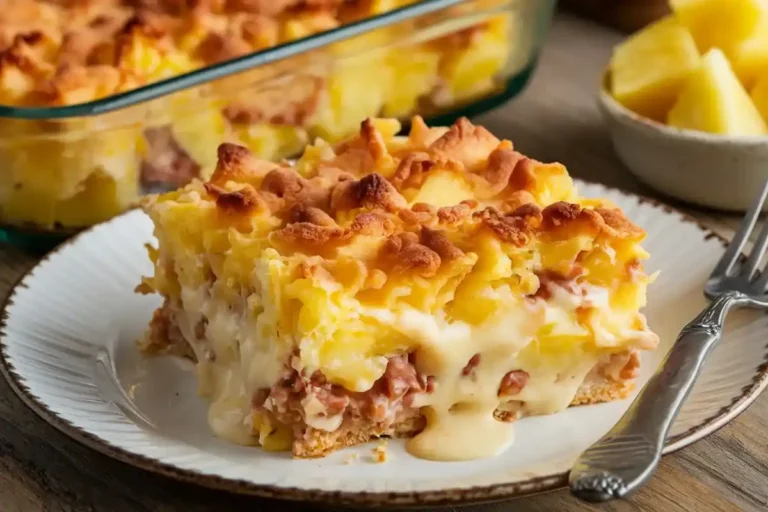
Pineapple Casserole Recipe: A Sweet and Savory Classic
A classic Southern dish that balances sweet and savory flavors, pineapple casserole is a beloved addition to holiday tables and potluck gatherings. With its easy-to-find ingredients and simple preparation, this recipe delivers a memorable combination of cheesy richness, fruity sweetness, and a crunchy, buttery topping.
- Total Time: 40 minutes
- Yield: 8 servings 1x
Ingredients
- 2 (20-ounce) cans of pineapple chunks, drained
- 1 cup granulated sugar
- 6 tablespoons all-purpose flour
- 2 cups sharp cheddar cheese, grated
- 1 ½ cups crushed Ritz crackers (about 1 sleeve)
- ½ cup unsalted butter, melted
Instructions
- Preheat your oven to 350°F (175°C) and grease a 9×13-inch baking dish.
- In a large mixing bowl, combine the drained pineapple, sugar, flour, and grated cheddar cheese. Stir until evenly coated.
- Pour the pineapple mixture into the prepared baking dish, spreading it out evenly.
- In a separate bowl, mix the crushed Ritz crackers with melted butter. Sprinkle the cracker topping over the pineapple mixture.
- Bake in the preheated oven for 25–30 minutes, or until the topping is golden brown and the casserole is bubbling at the edges.
- Let the casserole rest for 5–10 minutes before serving.
Notes
- For a less sweet casserole, reduce the sugar to ¾ cup.
-
Gluten-free crackers and gluten-free flour can be used as substitutes.
-
For added flavor, try a pinch of cinnamon or a handful of chopped pecans in the topping.
-
This casserole reheats well, making it a great make-ahead option.
- Prep Time: 10 minutes
- Cook Time: 30 minutes
- Category: Dessert
- Method: Baking
Nutrition
- Serving Size: 1/8 of casserole
- Calories: 320
- Sugar: 20g
- Sodium: 420mg
- Fat: 16g
- Saturated Fat: 9g
- Unsaturated Fat: 6g
- Carbohydrates: 38g
- Fiber: 1g
- Protein: 5g
- Cholesterol: 35mg
Keywords: pineapple casserole, Southern pineapple casserole, sweet and savory side dish
You’ll also like
- Banana Bread Recipe with 2 Bananas
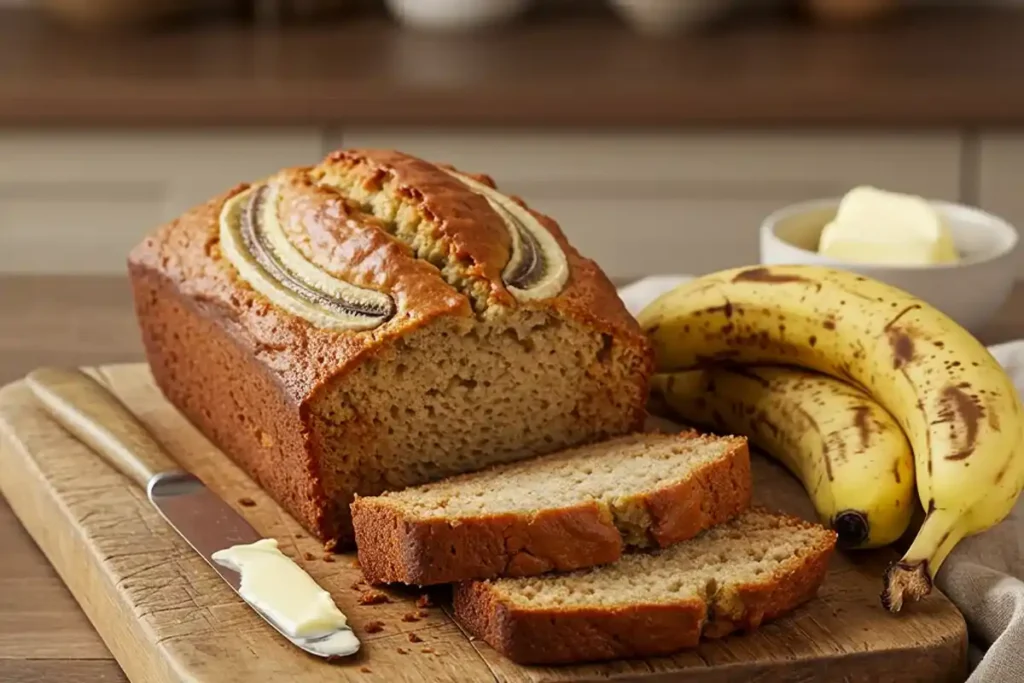
- Delicious Churro Cheesecake Bars Recipe – Easy Dessert Delight!
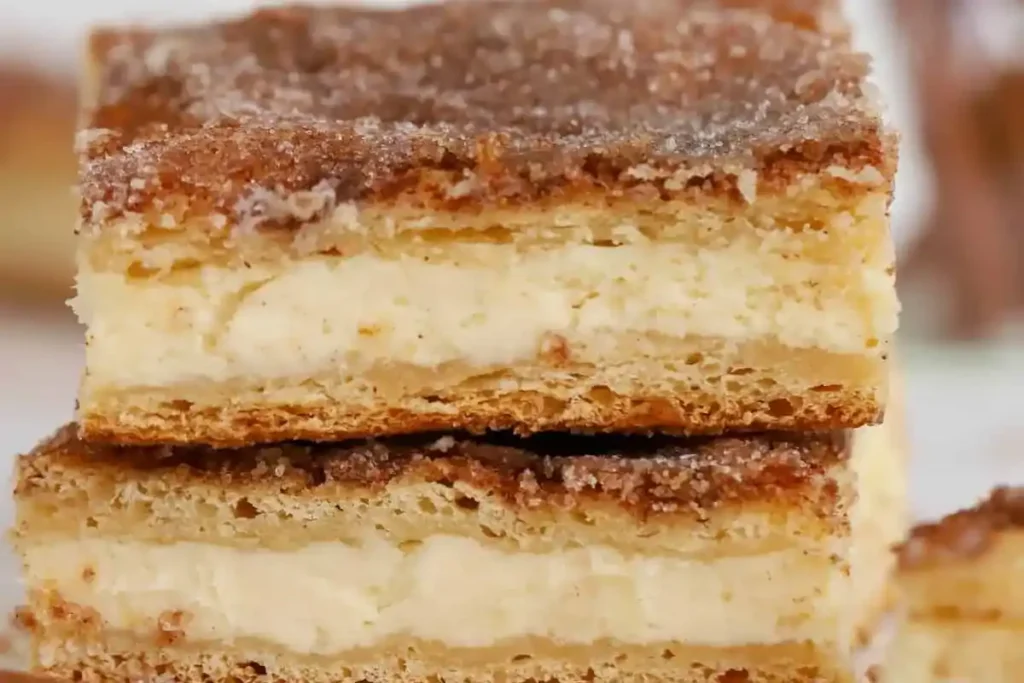
- Sure Jell Recipes: How to Make Perfect Jams & Jellies
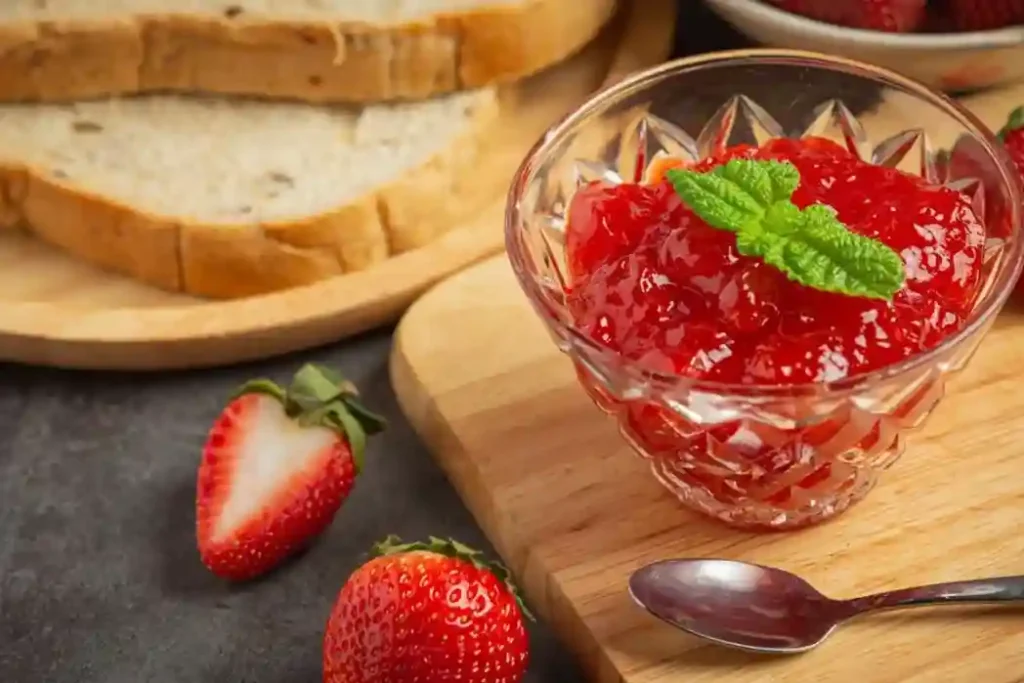
- Delicious Steelhead Trout Recipe: A Flavorful Guide
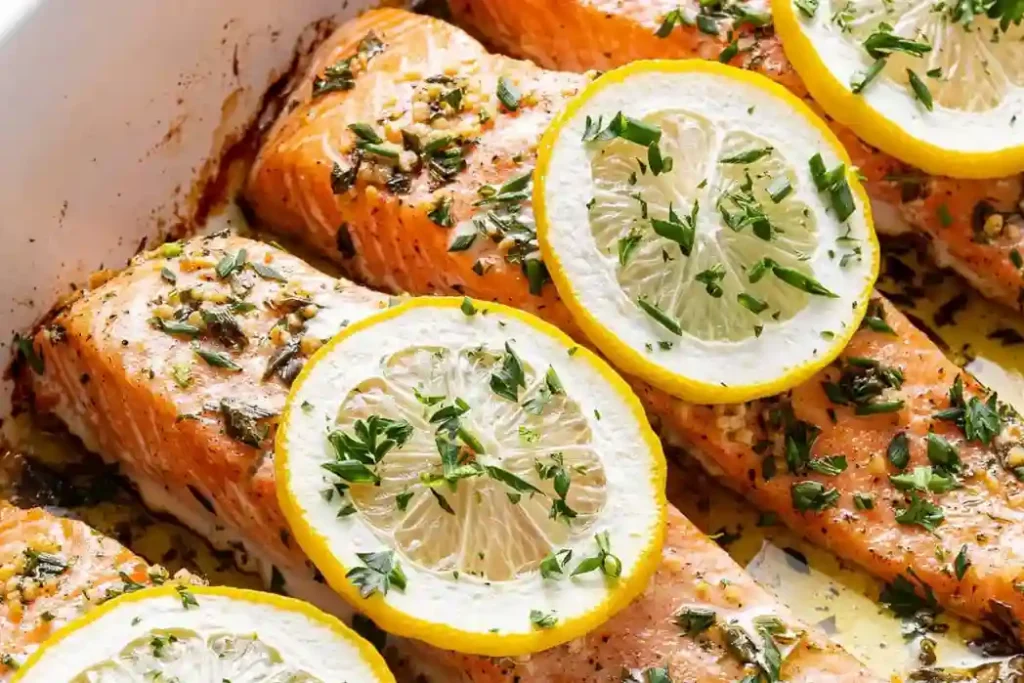
- Ultimate Peach Crumble Recipe: Sweet & Crunchy Delight
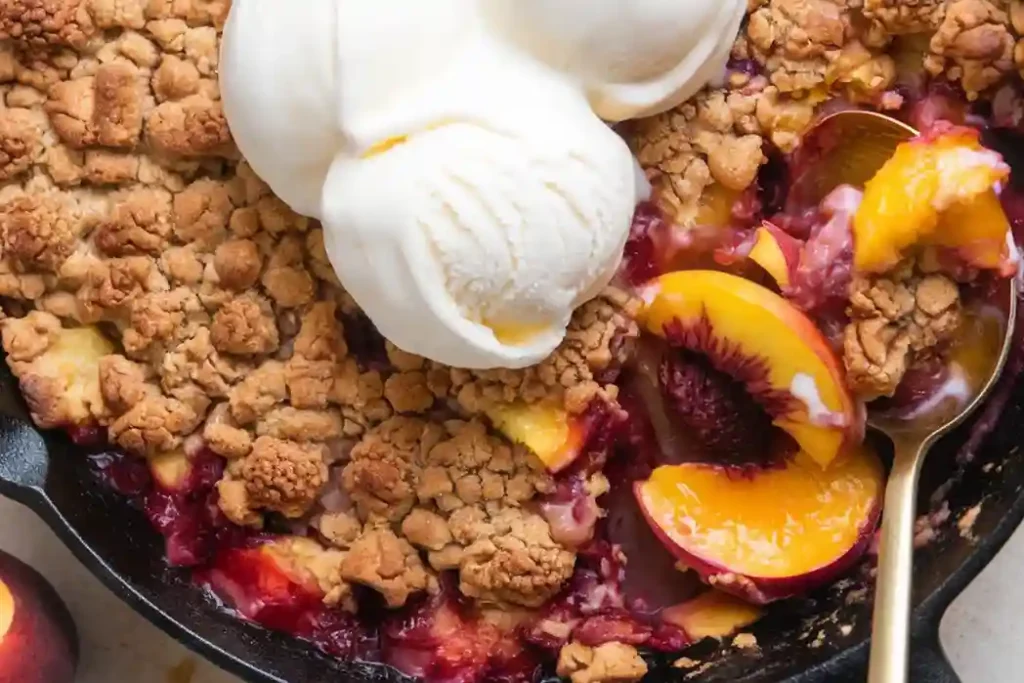
- Easy Step-by-Step Brioche Loaf Recipe for Perfect Breakfast Bread

